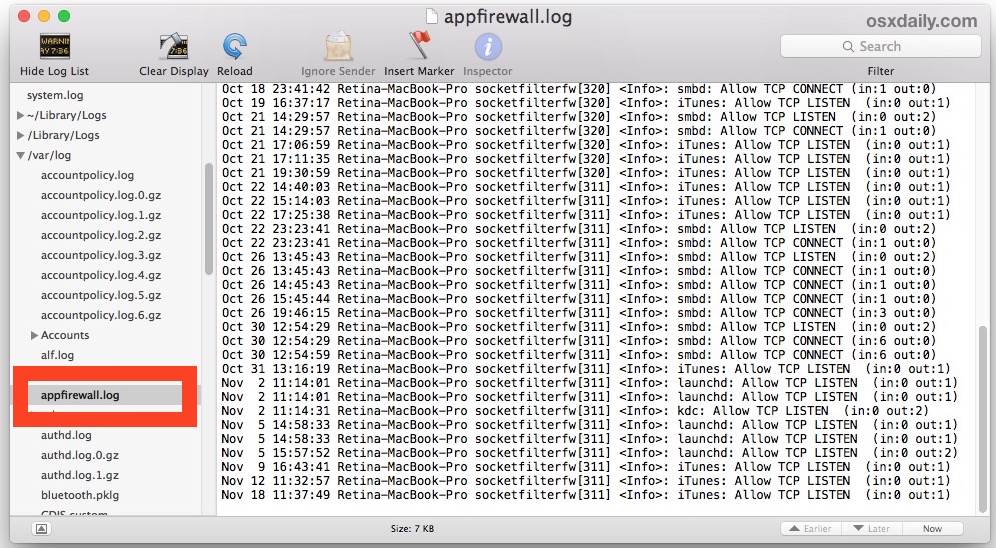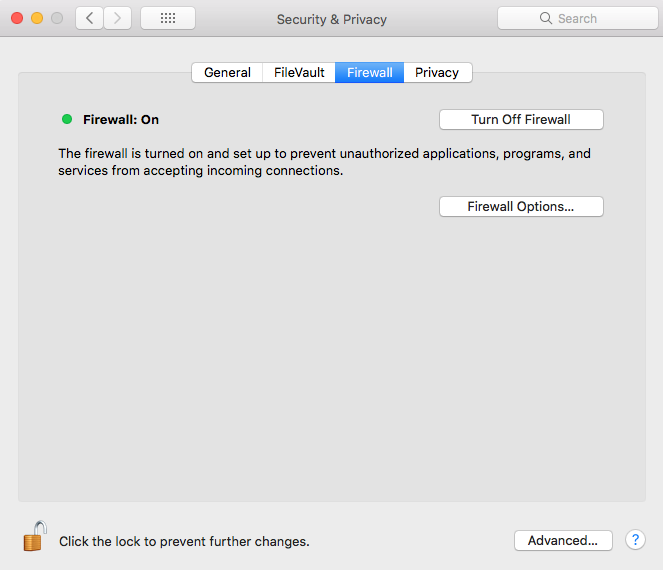Application Firewall For Mac
While you can certainly spend money on firewall applications for your Mac—the aforementioned Norton Security application will set you back a minimum of $45 per year—your Mac, no surprise. It depends on your environment. If you have a single computer then there is no reason not to turn it on. Personally, I’ve got multiple Macs (7) at home, have it off, and rely on the router to block incoming ports except for a few that get forwarde. 01 – One Periodic’s Hands Off! $ 49.99. To keep you and your computer secure, Hands Off!
Use a firewall to prevent unwanted connections on Mac. A firewall can protect your Mac from unwanted contact initiated by other computers when you’re connected to the internet or a network. However, your Mac can still allow access through the firewall for some services and apps. Blocking an app’s access through the firewall could. Click the Firewall tab to display the settings you see below. If your Mac’s firewall hasn’t yet been turned on, click the Turn On Firewall button to start the ball rolling. (In the above image, this button has toggled to Turn Off Firewall because your Mac’s firewall is already on.) Is the Turn On Firewall button disabled?
Firewall is software that’s there to protect you so it’s best to keep it turned on. With Firewall running, your Mac takes care of everything — automatically determining whether or not an application is allowed to send or receive traffic from the network. It does this using Code Signing Certificates that are issued to trusted applications. Without the proper certification, an app isn’t allowed through. Think of it like a bouncer on the door of a club — if an app doesn’t have the proper ID it ain’t coming in.
There may be times where Firewall isn't needed, though. Say, for example, you’re playing a video game and don’t want to access the online multiplayer modes. Or antivirus software that you’ve installed is conflicting with Mac’s Firewall application.
Turning off Firewall solves these problems. But you should be aware that, while switching off Firewall can stop apps on your computer from sending traffic to the network, it provides free reign for incoming connections, leaving you vulnerable to malware and hackers.
Clean your Mac before changing settings
Before we show you how to turn Firewall on and off, it’s recommended that you have a cleanup of apps on your system, particularly those that you’ve previously deleted. If you’ve ever downloaded an app by mistake and uninstalled it or found an app to be malicious and sent it to the Trash, there’s every chance that their remnants still exist on your system.
If that’s the case and you have Firewall switched off, these apps will be able to send and receive traffic, putting your Mac at serious risk.
So, if you plan on playing around with the Firewall settings, use a tool like CleanMyMac X to find and remove any unwanted files that exist on your system. CleanMyMac scans all of your disks and compiles installed apps. It also identifies broken and outdated apps so that you can easily remove them.
Here’s how to use it:
Application Firewall For Mac Windows 10
- Download and launch CleanMyMac X. (Free download)
- Click on the Uninstaller tab.
- Click on View All Applications and select any apps that you wish to remove from the list. Apps can be sorted by Name, Size, Selection, and Last Launch Date to help your search.
- Click on Complete Uninstallation from the dropdown menu.
- Click on the Uninstall button and enter your admin password when prompted.
Mac Firewall Settings
Selected apps will now be completely removed from your system.
Okay, with that out of the way, let’s get into enabling and disabling Firewall.
How to turn on Firewall on Mac
Mac’s Firewall settings can be found in the Security and Privacy preference in System Preferences.
To enable Firewall in macOS and OS X v10.6 or later:
- Go to System Preferences > Security & Privacy.
- Click on the Firewall tab.
- Click on the lock icon in the bottom left corner of the window and enter your administrator password.
- Click Turn On Firewall (or Start in OS X).
In v10.5 of OS X, Firewall is enabled slightly differently:
- Go to System Preferences > Security.
- Click on the Firewall tab.
- Click on the lock icon in the bottom left corner of the window and enter your administrator password.
- Click Start.
How to disable Firewall for Mac
Turning off the Firewall is simply a case of following the same instructions as above and clicking on the Turn Off Firewall button.
Application Firewall Macos
To do this, you may need to enter your administrator password.
Firewall advanced settings
By clicking on the Firewall Options button (or Advanced for OS X) you’ll find additional settings that give you more control over how the Firewall performs.
In the list, you’ll see all of the apps that are currently allowed to send and receive network traffic. By clicking on the application to highlight it and hitting the '-' button, you can remove an app from the list. Alternatively, clicking on the '+' button lets you add a new app to the list.
You’ll also be presented with three options:
Block all incoming connections — this blocks all connections other than those required for basic internet services.
Automatically allow signed software to receive incoming connections — this automatically allows software signed with a valid certificate to gain access to the network for sending and receiving traffic.
Enable stealth mode — this prevents Mac from responding to probing requests.
Check the boxes for any settings you'd like to enable and hit OK to confirm.
The great thing about Firewall for Mac is that it takes care of everything for you, regulating the access of apps to the network to keep your system safe from malicious activity. As said, it’s best to keep Firewall turned on and let it does its thing. But if you do plan on turning it off, even just for a short time, run CleanMyMac X prior to doing so to rid your Mac of old apps lurking in the depths of your system.
Best Firewall For Mac
These might also interest you:
The tools to automate OS X firewall events from the command line are still stored in /usr/libexec/ApplicationFirewall. And you will still use socketfilterfw there for much of the heavy lifting. However, now there are much more helpful and functional options in socketfilterfw that will allow you to more easily script the firewall. Some tricks I’ve picked up with the Mac Firewall/alf scripting:- Configure the firewall fully before turning it on (especially if you’re doing so through something like Casper, FileWave, Munki, or Absolute Manage where you might kick yourself out of your session otherwise).
- Whatever you do, you can always reset things back to defaults by removing the com.apple.alf.plist file from /Library/Preferences replacing it with the default plist from /usr/libexec/ApplicationFirewall/com.apple.alf.plist.
- Configure global settings, then per-application settings, then enable the firewall. If a remote system, do ;wait; and then enable the first time to make sure everything works before enabling the firewall for good.
- To debug, use the following command: “/usr/libexec/ApplicationFirewall/socketfilterfw -d”
/usr/libexec/ApplicationFirewall/socketfilterfw --setblockall on To see if block all is enabled: /usr/libexec/ApplicationFirewall/socketfilterfw --getblockall The output would be as follows, if successful: Firewall is set to block all non-essential incoming connections A couple of global options that can be set. Stealth Mode: /usr/libexec/ApplicationFirewall/socketfilterfw --setstealthmode on To check if stealth mode is enabled: /usr/libexec/ApplicationFirewall/socketfilterfw --getstealthmode Firewall logging: /usr/libexec/ApplicationFirewall/socketfilterfw --setloggingmode on You can also control the verbosity of logs, using throttled, brief or detail. For example, if you need to troubleshoot some issues, you might set the logging to detail using the following command: /usr/libexec/ApplicationFirewall/socketfilterfw --setloggingopt: detail To start the firewall: /usr/libexec/ApplicationFirewall/socketfilterfw --setglobalstate on While it would be nice to think that that was going to be everything for everyone, it just so happens that some environments actually need to allow traffic. Therefore, traffic can be allowed per signed binary. To allow signed applications:
While it would be nice to think that that was going to be everything for everyone, it just so happens that some environments actually need to allow traffic. Therefore, traffic can be allowed per signed binary. To allow signed applications: /usr/libexec/ApplicationFirewall/socketfilterfw --setallowsigned on To check if you allow signed apps: 
/usr/libexec/ApplicationFirewall/socketfilterfw --getallowsigned This will allow all TRUSTEDAPPS. The –listapps option shows the status of each filtered application: /usr/libexec/ApplicationFirewall/socketfilterfw --listapps To check if an app is blocked: /usr/libexec/ApplicationFirewall/socketfilterfw –getappblocked /Applications/MyApp.app/Contents/MacOS/myapp This shows the number of exceptions, explicitly allowed apps and signed exceptions as well as process names and allowed app statuses. There is also a list of TRUSTEDAPPS, which will initially be populated by Apple tools with sharing capabilities (e.g. httpd & smbd). If you are enabling the firewall using a script, first sign your applications that need to allow sharing but are not in the TRUSTEDAPPS section by using the -s option along with the application binary (not the .app bundle): 
/usr/libexec/ApplicationFirewall/socketfilterfw -s /Applications/MyApp.app/Contents/MacOS/myapp Once signed, verify the signature: Mac Network Firewall
/usr/libexec/ApplicationFirewall/socketfilterfw -v /Applications/MyApp.app/Contents/MacOS/myapp Once signed, trust the application using the –add option:
Once signed, trust the application using the –add option: /usr/libexec/ApplicationFirewall/socketfilterfw --add /Applications/MyApp.app/Contents/MacOS/myapp To see a list of trusted applications. You can do so by using the -l option as follows (the output is pretty ugly and needs to be parsed better): /usr/libexec/ApplicationFirewall/socketfilterfw -l If, in the course of your testing, you determine the firewall just isn’t for you, disable it: /usr/libexec/ApplicationFirewall/socketfilterfw --setglobalstate off To sanity check whether it’s started: /usr/libexec/ApplicationFirewall/socketfilterfw --getglobalstate Or to manually stop it using launchctl (should start again with a reboot): launchctl unload /System/Library/LaunchAgents/com.apple.alf.useragent.plist launchctl unload /System/Library/LaunchDaemons/com.apple.alf.agent.plist If you disable the firewalll using launchctl, you may need to restart services for them to work again.